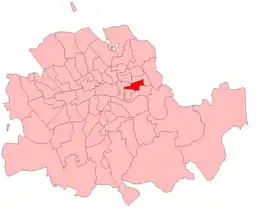W. C. Steadman | |
|---|---|
 William Steadman | |
| Member of Parliament for Finsbury Central | |
| In office 1906-January 1910 | |
| President of the Trades Union Congress | |
| In office 1902 | |
| Member of Parliament for Stepney | |
| In office 1898–1900 | |
| Personal details | |
| Born | 12 July 1851 Poplar, London, England |
| Died | 20 July 1911 (aged 60) |
| Political party | Lib-Lab/Liberal Progressive |
William Charles Steadman (12 July 1851 – 20 July 1911) was a prominent trade unionist and Liberal or Lib-Lab politician.
Life
Born in Poplar, London, Steadman began work at the age of eight, and in 1866 became a barge builder. In 1873, he joined the River Thames Barge Builders Trades Union, becoming its general secretary in 1879 and holding the post until 1908. In 1890, he led a successful eighteen-week strike, raising his profile. In 1892, Steadman was elected as a Progressive Party member of London County Council (LCC), representing Stepney. In the 1892 general election he unsuccessfully stood as the Liberal Party candidate for Mid Kent; he lost again in the 1895 election in Hammersmith.
He joined the Fabian Society. Steadman was finally elected as a Lib–Lab Member of Parliament (MP) for Stepney at the March by-election in 1898 which took place because of the death of F. W. Isaacson in February, who had held the seat since 1896.[1]
This meant that he now represented Stepney both in Parliament and on the London County Council, having been re-elected there in elections in 1895 and 1898. In 1899, he was elected to the Parliamentary Committee (later the General Council) of the Trades Union Congress (TUC), and in 1902 he was its President. Steadman lost his seat in Parliament at the 1900 general election to Major William Evans-Gordon.[2]
He continued to represent Stepney on the LCC, being re-elected there in 1901 and 1904. He went on to chair the first conference of the Labour Representation Committee, but left the organisation when asked to leave the Liberal Party. In 1904, he was elected as the Parliamentary Secretary of the TUC, the post which later became the General Secretary.
In 1906, Steadman again stood for the Liberal Party, and won Finsbury Central. He lost the seat in the January 1910 general election. In 1911, he announced his intention to stand down from his TUC post, but died, aged 60, before this could take effect.
Election results

| Party | Candidate | Votes | % | ±% | |
|---|---|---|---|---|---|
| Conservative | Walter Tuckfield Goldsworthy | 5,017 | 60.8 | 6.7 | |
| Lib-Lab | William Charles Steadman | 3,238 | 39.2 | -6.7 | |
| Majority | 1,779 | ||||
| Turnout | 12,378 | 66.7 | |||
| Conservative hold | Swing | ||||

| Party | Candidate | Votes | % | ±% | |
|---|---|---|---|---|---|
| Lib-Lab | William Charles Steadman | 2,492 | 50.2 | ||
| Conservative | William Eden Evans-Gordon | 2,472 | 49.8 | ||
| Majority | 20 | 0.4 | |||
| Turnout | 6,387 | 77.7 | |||
| Lib-Lab gain from Conservative | Swing | +5.8 | |||
| Party | Candidate | Votes | % | ±% | |
|---|---|---|---|---|---|
| Conservative | William Eden Evans-Gordon | 2,783 | 61.8 | ||
| Lib-Lab | William Charles Steadman | 1,718 | 38.2 | ||
| Majority | 1,065 | 23.6 | |||
| Turnout | 5,878 | 76.6 | |||
| Conservative gain from Lib-Lab | Swing | +12.0 | |||

| Party | Candidate | Votes | % | ±% | |
|---|---|---|---|---|---|
| Lib-Lab | William Charles Steadman | 3,493 | 55.5 | ||
| Conservative | Edward Alfred Goulding | 2,799 | 44.5 | ||
| Majority | 694 | 11.0 | |||
| Turnout | 8,279 | 76.0 | |||
| Lib-Lab gain from Conservative | Swing | +8.7 | |||
| Party | Candidate | Votes | % | ±% | |
|---|---|---|---|---|---|
| Conservative | Martin Archer-Shee | 3,559 | 52.8 | ||
| Lib-Lab | William Charles Steadman | 3,187 | 47.2 | ||
| Majority | 372 | 5.6 | |||
| Turnout | |||||
| Conservative gain from Lib-Lab | Swing | +8.3 | |||
References
- ↑ The Liberal Year Book for 1905. London: The Liberal Publication Dept. (in association with the National Liberal Federation and the Liberal Central Association). 1905. pp. 302–3. Steadman won by just 20 votes, beating the Conservative candidate William Evans-Gordon who finally gained the seat in 1900.
- ↑ Liberal Year Book 1905, p. 302-3.